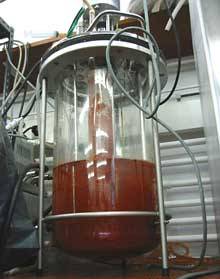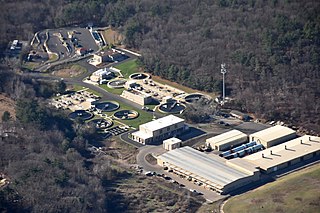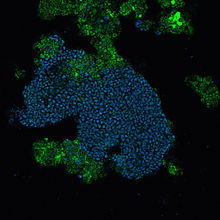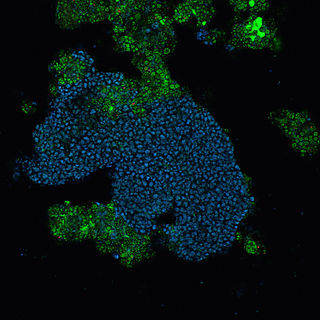
Enterobacteriaceae is a large family of Gram-negative bacteria. It was first proposed by Rahn in 1936, and now includes over 30 genera and more than 100 species. Its classification above the level of family is still a subject of debate, but one classification places it in the order Enterobacterales of the class Gammaproteobacteria in the phylum Proteobacteria.

Phosphorus is a chemical element with the symbol P and atomic number 15. Elemental phosphorus exists in two major forms, white phosphorus and red phosphorus, but because it is highly reactive, phosphorus is never found as a free element on Earth. It has a concentration in the Earth's crust of about one gram per kilogram. In minerals, phosphorus generally occurs as phosphate.

A Phosphate is a chemical derivative of phosphoric acid. The phosphate ion (PO
4)3−
is an inorganic chemical, the conjugate base that can form many different salts. In organic chemistry, a phosphate, or organophosphate, is an ester of phosphoric acid. Of the various phosphoric acids and phosphates, organic phosphates are important in biochemistry and biogeochemistry, and inorganic phosphates are mined to obtain phosphorus for use in agriculture and industry. At elevated temperatures in the solid state, phosphates can condense to form pyrophosphates.

Enterobacterales with its type genus Enterobacter is an order of Gram-negative bacteria.

Anammox, an abbreviation for anaerobic ammonium oxidation, is a globally important microbial process of the nitrogen cycle that takes place in many natural environments. The bacteria mediating this process were identified in 1999, and were a great surprise for the scientific community. "Anammox" is also the trademarked name for an anammox-based ammonium removal technology developed by the Delft University of Technology.

A constructed wetland (CW) is an artificial wetland to treat municipal or industrial wastewater, greywater or stormwater runoff. It may also be designed for land reclamation after mining, or as a mitigation step for natural areas lost to land development.

Citrus greening disease is a disease of citrus caused by a vector-transmitted pathogen. The causative agents are motile bacteria, Candidatus Liberibacter spp. The disease is vectored and transmitted by the Asian citrus psyllid, Diaphorina citri, and the African citrus psyllid, Trioza erytreae, also known as the two-spotted citrus psyllid. It has also been shown to be graft-transmissible. Three different types of HLB are currently known: The heat-tolerant Asian form, and the heat-sensitive African and American forms. The disease was first described in 1929 and first reported in China in 1943. The African variation was first reported in 1947 in South Africa, where it is still widespread. Eventually, it affected the United States, reaching Florida in 2005. Within three years, it had spread to the majority of citrus farms. The rapid increase in this disease has threatened the citrus industry not only in Florida, but the entire US. As of 2009, 33 countries have reported HLB infection in their citrus crop.
Enhanced biological phosphorus removal (EBPR) is a sewage treatment configuration applied to activated sludge systems for the removal of phosphate.
Polyphosphate-accumulating organisms (PAOs) are a group of bacteria that, under certain conditions, facilitate the removal of large amounts of phosphorus from wastewater in a process, called enhanced biological phosphorus removal (EBPR). PAOs accomplish this removal of phosphate by accumulating it within their cells as polyphosphate. PAOs are by no means the only bacteria that can accumulate polyphosphate within their cells and in fact, the production of polyphosphate is a widespread ability among bacteria. However, the PAOs have many characteristics that other organisms that accumulate polyphosphate do not have, that make them amenable to use in wastewater treatment. Specifically, this is the ability to consume simple carbon compounds without the presence of an external electron acceptor by generating energy from internally stored polyphosphate and glycogen. Most other bacteria cannot consume under these conditions and therefore PAOs gain a selective advantage within the mixed microbial community present in the activated sludge. Therefore, wastewater treatment plants that operate for enhanced biological phosphorus removal have an anaerobic tank prior to the other tanks to give PAOs preferential access to the simple carbon compounds in the wastewater that is influent to the plant.

Sewage treatment is the process of removing contaminants from municipal wastewater, containing mainly household sewage plus some industrial wastewater. Physical, chemical, and biological processes are used to remove contaminants and produce treated wastewater that is safe enough for release into the environment. A by-product of sewage treatment is a semi-solid waste or slurry, called sewage sludge. The sludge has to undergo further treatment before being suitable for disposal or application to land.

Nutrient pollution, a form of water pollution, refers to contamination by excessive inputs of nutrients. It is a primary cause of eutrophication of surface waters, in which excess nutrients, usually nitrogen or phosphorus, stimulate algal growth. Sources of nutrient pollution include surface runoff from farm fields and pastures, discharges from septic tanks and feedlots, and emissions from combustion. Excess nutrients have been summarized as potentially leading to:
Activated sludge model is a generic name for a group of mathematical methods to model activated sludge systems. The research in this area is coordinated by a task group of the International Water Association (IWA). Activated sludge models are used in scientific research to study biological processes in hypothetical systems. They can also be applied on full scale wastewater treatment plants for optimisation, when carefully calibrated with reference data for sludge production and nutrients in the effluent.
Nitrospirae is a phylum of bacteria. It contains only one class, Nitrospira, which itself contains one order (Nitrospirales) and one family (Nitrospiraceae). It includes multiple genera, such as Nitrospira, the largest. The first member of this phylum, Nitrospira marina, was discovered in 1985. The second member, Nitrospira moscoviensis, was discovered in 1995.

In the last 30 years Lake Winnipeg has experienced a steady surge of blue-green algae growth and although algae grows naturally in the lake, excessive blue-green algae blooms are caused by high ratio levels of nitrogen and phosphorus draining into the lake via rivers and surface runoff. Up to five and a half million people rely on the health of Lake Winnipeg. The lake is an economical powerhouse that supports a $100 million a year tourism industry and a $25 million a year fishing industry. Healthy algae populations play an important role in keeping lake Winnipeg's ecological systems balanced. Green algae provides food for zooplankton, which are then eaten by larger fish in the lake. However the toxins that blue-green algae release can destroy fresh water ecosystems and can be dangerous for humans and other species. Very high levels of the algae toxin microcystin closed Victoria Beach off from the public in the summer of 2003. Grand Beach and other surrounding settlements along the lake are often closed for a short time during summer months due to E. coli and algae-toxin related threats. Immense algae blooms have appeared in the northern part of Lake Winnipeg in the last decade with hundreds of square kilometers of the lake covered with a thick toxic layer of blue-green algae. Local residents in surrounding communities say the blue-green algae is well known for creating deadly water conditions in prairie dugouts and have been known to even kill livestock. Commercial and aboriginal fishermen on the lake often find their nets temporarily disabled during the summer months because of the thick algae conditions. The Lake Winnipeg algae blooms are considered the worst algae problem of any large freshwater lake in the world.
CandidatusScalindua wagneri is a Gram-negative coccoid-shaped bacterium that was first isolated from a wastewater treatment plant. This bacterium is an obligate anaerobic chemolithotroph that undergoes anaerobic ammonium oxidation (anammox). It can be used in the wastewater treatment industry in nitrogen reactors to remove nitrogenous wastes from wastewater without contributing to fixed nitrogen loss and greenhouse gas emission.
"Candidatus Scalindua" is a bacterial genus, and a proposed member of the order Planctomycetes. These bacteria lack peptidoglycan in their cell wall and have a compartmentalized cytoplasm. They are ammonium oxidizing bacteria found in marine environments.
James L. Barnard is a South African born engineer living in the United States who is known globally as the pioneer of biological nutrient remover, a non-chemical means of water treatment to remove nitrogen and phosphorus from used water.

β-propeller phytases (BPPs) are a group of enzymes (i.e. protein superfamily) with a round beta-propeller structure. BPPs are phytases, which means that they are able to remove (hydrolyze) phosphate groups from phytic acid and its phytate salts. Hydrolysis happens stepwise and usually ends in myo-inositol triphosphate product which has three phosphate groups still bound to it. The actual substrate of BPPs is calcium phytate and in order to hydrolyze it, BPPs must have Ca2+ ions bound to themselves. BPPs are the most widely found phytase superfamily in the environment and they are thought to have a major role in phytate-phosphorus cycling in soil and water. As their alternative name alkaline phytase suggests, BPPs work best in basic (or neutral) environment. Their pH optima is 6–9, which is unique among other phytase structural groups like histidine acid phytases.












